#Society of Wood Engravers
Text

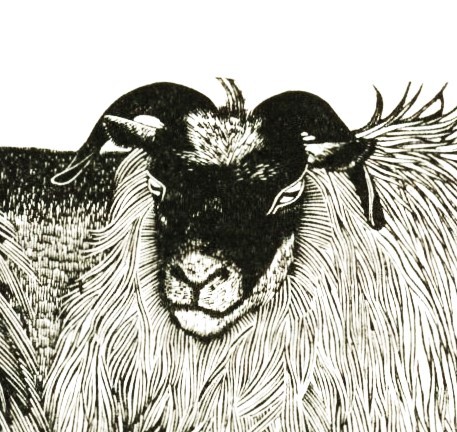
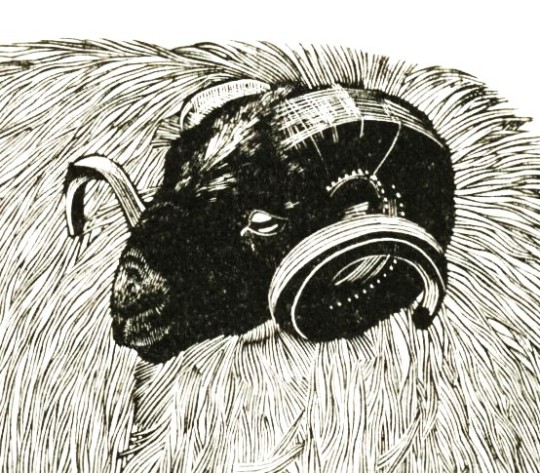

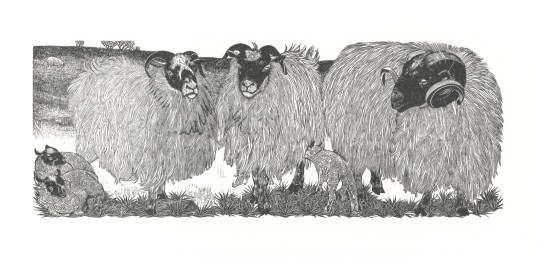
Wood Engraving Wednesday
SARAH VAN NIEKERK
English artist Sarah Van Niekerk (1934 - 2018) was an award-winning Illustrator and wood engraver, a member of the Society of Wood Engravers (SWE), and the Society's chair, 1995-1998. This print, Rams, was printed from the original block in 2020 Vision: Nineteen Wood Engravers, One Collector, and the Artists Who Inspired Them, printed in 2020 by Patrick Randle’s Nomad Letterpress at the Whittington Press in Cheltenham, Gloucestershire, in an edition of 340 copies for the 100th anniversary of the Society of Wood Engravers. Unfortunately, Van Niekerk died during the planning of the book and her daughter Jess wrote the text for mother's entry and helped select the block to be printed.
Sarah Van Niekerk attended the Central School of Arts and Crafts (1951-1954) where she studied with wood engraver and sculptor Gertrude Hermes who greatly influenced her work. She continued her education at the Slade School (1955-1956) and much later taught wood engraving at the Royal Academy of Art (1976-1986) and the City and Guilds Art School (1979-1998), and for many years was a tutor at West Dean College. Besides being a member of SWE, she was also a Fellow of the Royal Society of Painter-Printmakers and a Royal West of England Academician.

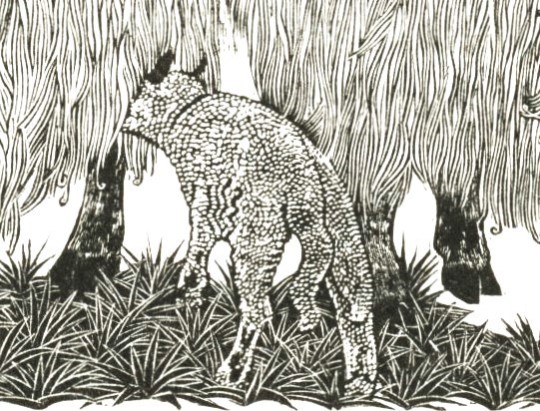
View another post with work by Sarah Van Niekerk.
View a post with work by Van Niekerk's mentor Gertrude Hermes.
View other posts from 2020 Vision.
View more posts with women wood engravers.
View more posts with wood engravings!
#Wood Engraving Wednesday#Women's History Month#wood engravings#wood engravers#women wood engravers#Sarah Van Niekerk#Rams#sheep#lambs#2020 Vision#Nomad Press#Whittington Press#Patrick Randle#Society of Wood Engravers#letterpress printing#fine press books#artistic influences#Gertrude Hermes
126 notes
·
View notes
Text





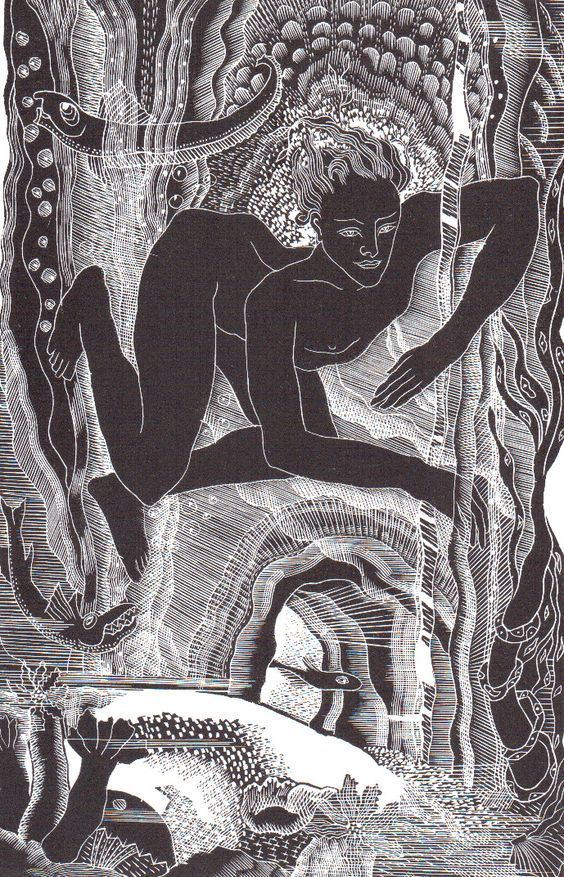
Lettice Sandford, British printmaker, draughtsman, watercolourist, publisher and craft worker. 1902 - 1993.
Born 1902 in St Albans, Hertfordshire. Studied at the Byam Shaw and Vicat Cole School of Art, then at Chelsea School of Art, 1926-9, working under Percy Jowett (1882-1955). She was taught to engrave on wood by Robert Day and etching by Graham Sutherland (q.v.). She married Christopher Sandford in 1929. Their son was the playwrite Jeremy Sandford (1930-2003). With her husband ran the Boar's Head Press, whose books were printed at the Chiswick Press. In 1933 they bought the Golden Cockerel Press from Robert Gibbings (q.v.). She illustrated many of their books: engraving on wood, copper and zinc and published two of her own children's books. After WWII she illustrated 4 books for the Folio Society. After the Press was sold in 1959 she and her husband created a small museum at their home in Eye Manor nr. Leominster. She became an expert in corn dollies, reviving the craft and writing a practical leaflet and 'Decorative Straw Work and Corn Dollies' 1964.
The British Museum
250 notes
·
View notes
Photo

Rockwell Kent (1882-1971)
WORKERS OF THE WORLD, UNITE! (BURNE JONES 111)
Wood engraving, 1937, on cream wove paper, signed in pencil, from the edition of 150, published by the American College Society of Print
#rockwell kent#drawing#sketch#engraving#Illustration#art#graphic art#graphic design#design gráfico#design graphique#1930s#vintage#labour#labor
238 notes
·
View notes
Text
THIS DAY IN GAY HISTORY
based on: The White Crane Institute's 'Gay Wisdom', Gay Birthdays, Gay For Today, Famous GLBT, glbt-Gay Encylopedia, Today in Gay History, Wikipedia, and more … FEBRUARY 24



1836 – Winslow Homer (d.1910) was an American landscape painter and printmaker, best known for his marine subjects. One of the most prolific and important American painters and printmakers of the second half of the nineteenth century, Winslow Homer created a distinctly American, modern classical style.
Homer dealt with many of the same themes that writers such as Henry Thoreau, Herman Melville, and Walt Whitman did, including the heroism displayed by ordinary individuals, when confronted by seemingly insuperable difficulties; the camaraderie and friendships enjoyed by soldiers and working men; and the isolation of the individual in the face of the "Other."
Born in Boston on February 24, 1836, Homer was initially trained as an artist by his mother, Henrietta Benson Winslow, who successfully exhibited watercolors of flowers and other still life subjects throughout her adult life.
Between 1855 and 1857, he was apprenticed to John H. Bufford, a nationally prominent commercial artist, based in Boston; with this training, he began to do free-lance work for Harper's Weekly and other magazines.
In 1861, Homer was commissioned by Harper's Weekly as a special artist/correspondent to record the events of the Civil War. Homer failed to produce the heroic battle scenes that his editors had wanted. Yet his images of the daily lives of ordinary soldiers greatly appealed to the magazine's readers and helped to establish his reputation.
Among other subjects, he represented guard duty (A Sharp-Shooter on Picket Duty, wood engraving, 1867); punishments for minor infractions (A Punishment for Intoxication, painting, 1863); medical care for the wounded (The Surgeon at Work at the Rear During an Engagement, wood engraving, 1862); and recreation (Soldier Dancing, drawing, 1862).

The Empty Sleeve at Newport
As the war ended, Homer revealed the personal "costs" of the conflict in such images as The Empty Sleeve at Newport (wood engraving, 1865), which represents a one-armed man, riding in a carriage with a sad, aloof well-dressed woman.
Very little is known about Homer's "private" life. He consistently refused to answer personal questions from critics and potential biographers, and he left no revealing diaries or other personal papers. His reclusiveness is indicated by the fact that he produced no self-portraits; in contrast, most American and European painters of the nineteenth century eagerly exploited the rapidly growing market for images of artists.
Most historians have adamantly maintained that Homer remained a bachelor because he was extraordinarily "shy" around women. However, it would seem more plausible to suggest that Homer simply may not have been interested in women sexually.
Constructing Homer as a solitary eccentric, who virtually withdrew from human society, most scholars have overlooked evidence of significant, intimate associations with other men.
One of his closest friends was Albert Kelsey, a fellow artist whom he initially met in 1858 in Massachusetts. In 1867, Kelsey traveled with Homer to Paris, where they lived together for the next two years.
A studio photograph, made while they were in Paris, mimics the conventions of marriage portraits, as do so many photographic portraits of male friends of this period. Kelsey inscribed the back of the photograph with the names "Damon and Pythias," famous ancient Greek heroes and lovers.In the 1890s, Homer remembered their friendship in the humorous and erotically suggestive drawing "Albert Kelsey riding a giant turtle in the Bahamas."
Homer's closest companion in the final years of his life was an African-American man, Lewis Wright, who worked as his servant and lived at his Prout's Neck, Maine estate from 1895 to 1910. There are indications that some of Homer's acquaintances were disconcerted by the apparent closeness of his friendship with Wright. While most "negative" reactions involved race, other "unmentionable" factors may also have been involved.
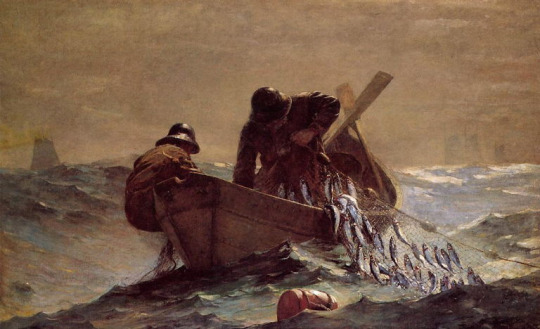
The Herring Net
Throughout his career, Homer created images that celebrated diverse aspects of male friendships. Thus, he depicted soldiers, unified in melancholy longing for peacetime home life (Home, Sweet Home, 1863); wilderness guides enjoying the beauties of nature (Two Guides, 1871); and fishermen laboring together (The Herring Net, 1885) and coping with dangerous storms (The Signal of Distress, 1890).
Homer died on September 29, 1910 in Prout's Neck, Maine.

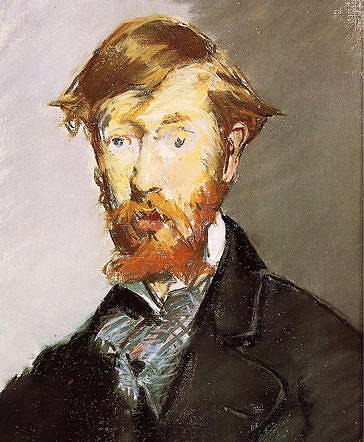
1852 – The Irish novelist, short-story writer, poet, art critic, memoirist and dramatist, George Moore was born on this date (d.1933). Moore came from a Roman Catholic landed family. He originally wanted to be a painter, and studied art in Paris during the 1870s. There, he befriended many of the leading French artists and writers of the day.
As a naturalistic writer, he was amongst the first English-language authors to absorb the lessons of the French realists, and was particularly influenced by the works of Émile Zola. His writings influenced James Joyce, according to the literary critic and biographer Richard Ellmann, and, although Moore's work is sometimes seen as outside the mainstream of both Irish and British literature, he is as often regarded as the first great modern Irish novelist.
According to Brian Lacey's new book, Queer Creatures: A History of Homosexuality in Ireland, Moore outed his good friend, the artist Edward Martyn, in his three-volume masterpiece Hail and Farewell (published between 1911 and 1914). Moore, who was attracted to the handsome young Yeats, later fell in love with the celebrated French painter Edouard Manet, who painted three portraits of him. Moore was influenced by the homosexual Oxford critic Walter Pater, and Moore's 1879 work, "Flowers of Passion," already contained references to Lesbianism. Moore's 1887 novel, A Mere Accident, also has a homosexual theme and its central character is again based on Martyn.

1868 – The first parade to have floats is staged at Mardi Gras in New Orleans, Louisiana.

1938 – A California appellate court upholds an oral copulation conviction of a man in a hotel after naval investigators listened in and heard his bed squeaking.

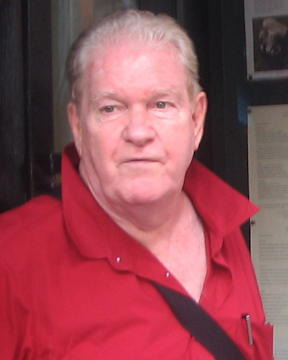
1939 – Doric Wilson (d.2011), the American playwright, was born on this date. Some people write for the "alternative" theatre because they aren't good enough for Broadway. Doric Wilson wrote for it because he was too good for the Great White Way.
Wilson was one of the first playwrights at NYC's legendary Caffe Cino, his comedy "And He Made A Her" opening there in 1961. Other Cino productions followed, including "Now She Dances!" (one-act version), "Babel Babel Little Tower " and "Pretty People" .
Street Theater, Wilson's best-known play, is a fictionalization of the Stonewall riots, an event in which Wilson took part. Using satire and exaggeration, Wilson recreates the milieu of street culture in Greenwich Village in the late 1960s, presenting characters variously described as "heavy leather, keys left," "a flower child," and "a street queen." The characters are archetypes representing both the disparate groups involved in the riot and also real people Wilson knew. A complex parody of Wilder's Our Town and Crowley's The Boys in the Band, the play is both deeply literary and deeply rooted in a particular time and place.
A veteran of the anti-war and civil rights demonstrations of the early 1960s-mid 1970s, Wilson was a participant in the Stonewall Riots. An active participant in the early gay liberation movement, Wilson was a member of the Gay Activists Alliance (GAA). He helped support himself as a bartender and manager of several bars and clubs that sprouted up in the wake of Stonewall, including such institutions as Spike, Ty's, and Brothers & Sisters Cabaret. Wilson's activism and his thorough immersion in New York's gay community are reflected significantly in his work.
In 1974, Wilson (with Billy Blackwell, Peter del Valle and John McSpadden) formed TOSOS (The Other Side of Silence), the first professional theatre company to deal openly and honestly with the gay experience. The company featured new plays and revivals by such writers as Brendan Behan, Noël Coward, Christopher Hampton, Charles Jurrist, Joe Orton, Terrence McNally, Robert Patrick, Sandra Scoppettone, Martin Sherman and Lanford Wilson. In June, 2001, Wilson, and directors Mark Finley and Barry Childs resurrected the company as TOSOS II. The original TOSOS and its production of Doric Wilson's play The West Street Gang are featured in "Perform", the new permanent exhibit on theatre at The Museum of New York City.
A pioneer in the Off-Off-Broadway movement, he was completely committed to alternative theater and over the past 25 years has written, directed and produced more than a hundred productions. Such plays as Forever After, A Perfect Relationship , and The West Side Gang made him not only "one of a handful of leading contemporary playwrights who deal frankly with the Gay experience," but a satirist of the first water whose targets - hypocrisy, cant, and simply human foibles - are universal.


1975 – Gary Lane and Larry Lane, born in Goldsboro, N.C., are identical twin actors, models, film producers and screenwriters. They are both gay. The twins have appeared in feature films and national TV ads and are three-time grand prize champions of reality TV competitions. They are best known for a film they co-produced and appeared in, Hollywood to Dollywood, a feature-length documentary released theatrically in 2012. The film, about their quest to personally deliver a screenplay they've written to singer-actress Dolly Parton, played at 60 film festivals and won 24 festival awards.
Since the early 2000s, the Lane twins have appeared in feature films, TV programs, reality TV shows and TV commercials. As teenagers, they appeared on several episodes of Dawson's Creek and played twin colonial flag bearers in the Mel Gibson film The Patriot (2000). Other film appearances include Zoolander (2001), New Best Friend (2002), Spider-Man (2002), The Girl Next Door (2004), Eating Out 3: All You Can Eat (2009), and Jack and Jill (2011)
youtube
The Lane Twins talk of their life
The twins have competed on and won $50,000 on NBC's Fear Factor; beat out 24 other contestants for the grand prize of $50,000 on ABC's Winter Wipeout; and won $125,000 on the reality TV competition Set For Life. Gary Lane said their goal for appearing on these shows was to win money to pay for music rights and production costs associated with their documentary Hollywood to Dollywood. "For every wipeout, I would say, 'that was for Jolene, and for every ouch, 'that was for Coat of Many Colors!,'" Gary Lane said, referring to the need to raise money for licensing rights to hit Parton songs.
The Lane twins wrote a screenplay, Full Circle, which includes a role tailored for Dolly Parton. They submitted the script to Parton's management, but Parton's managers returned it as "unsolicited material." The twins decided to drive from Los Angeles, where they live, to Parton's theme park in Tennessee, Dollywood. The goal was to try and hand their script to Parton during one of her appearances at Dollywood's 25th anniversary celebration. In addition, the documentary explores the Lane twins' concerns about their Southern hometown's potential reaction to the film (and to the brothers' homosexuality) and their desire for acceptance from their Southern Baptist mother. Also on the journey is Gary's partner, Michael Bowen, who has crafted a birdhouse for Ms. Parton. The journey to deliver their screenplay is the focus of their documentary feature, Hollywood to Dollywood, which played at 60 film festivals throughout 2011 and 2012, winning 24 awards.
Parton makes an appearance in the film. After viewing the documentary, she gave the twins rights to use her music and likeness in its promotions. The Lane twins donate 10 percent of each Hollywood to Dollywood DVD sold to Parton's Imagination Library, an organization that provides free books to young children and is part of the Dollywood Foundation.

Today's Gay Wisdom:

George Moore
Faith goes out of the window when beauty comes in at the door. - George Moore
The mind petrifies if a circle be drawn around it, and it can hardly be denied that dogma draws a circle round the mind. - George Moore
A man travels the world over in search of what he needs and returns home to find it. - George Moore
A great artist is always before his time or behind it. - George Moore
I am filled with pride when I think of the noble and exalted world that must have existed before Christian doctrine caused men to look upon women with suspicion and bade them to think of angels instead. - George Moore
The world is dying of machinery; that is the great disease, that is the plague that will sweep away and destroy civilization; man will have to rise against it sooner or later. - George Moore
The difficulty in life is the choice.
- George Moore



26 notes
·
View notes
Text

DAPHNE by Alfred de Vigny. (Paris: F-L Schmied, 1924) Designed and illustrated with 50 wood engravings by François-Louis Schmied. Art binding by Devauchelle .
Written in 1837 but not published until 1912, this novel is the most philosophical of the French Romantic poet’s work. It examines the role of the artist in society.
Midnight blue crushed Morocco inlaid and gilt in an Art Deco design inspired by Schmied. Covers have gold and silver geometric tooling, with metallic and tan morocco inlays. The engravings are enhanced with silver and gold.

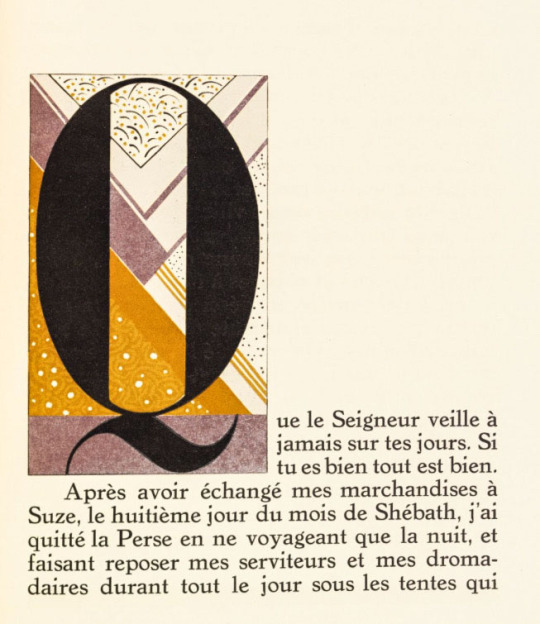
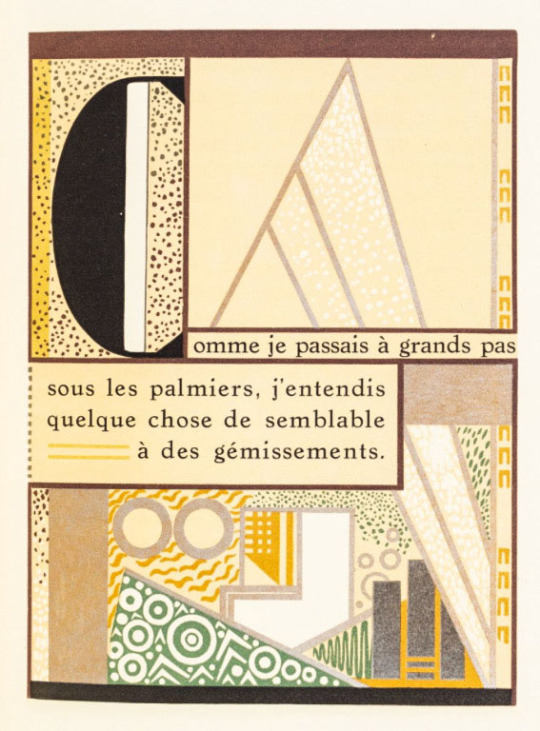
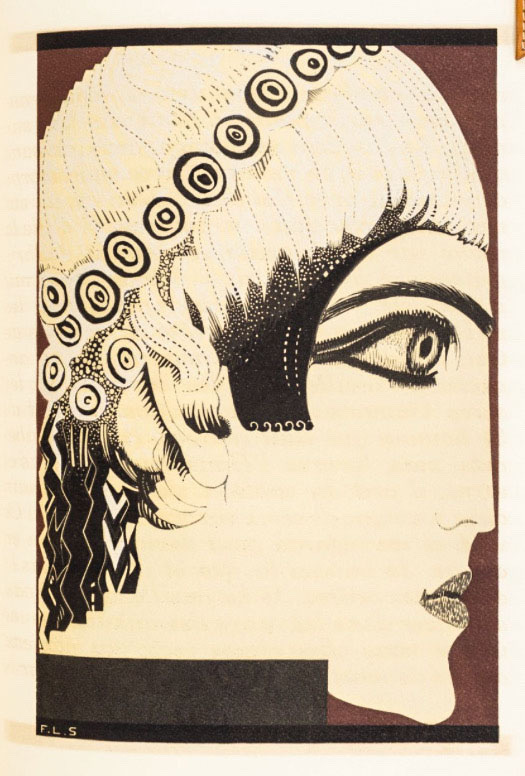
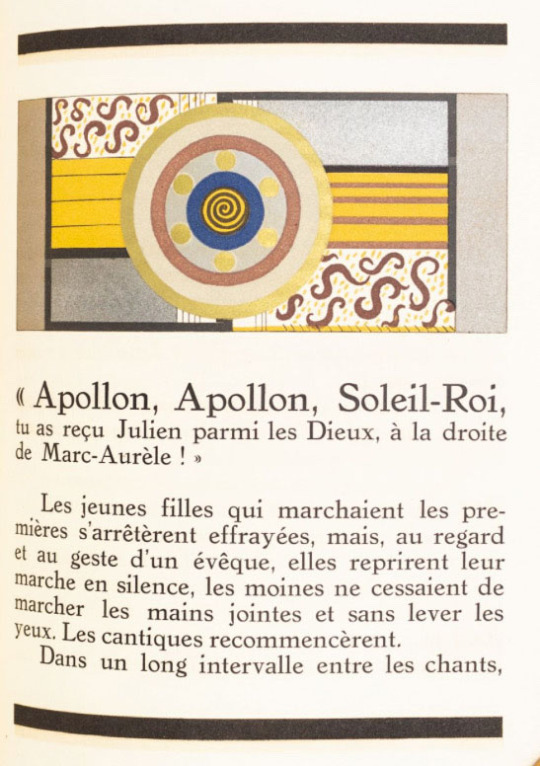
source
#beautiful books#book blog#books books books#book cover#books#vintage books#illustrated book#french romanticism#art decò#book binding#book design#art binding#alfred de vigny#francois louis schmied#devauchelle
69 notes
·
View notes
Text
What’s In A Name [ Din Djarin x OC ]
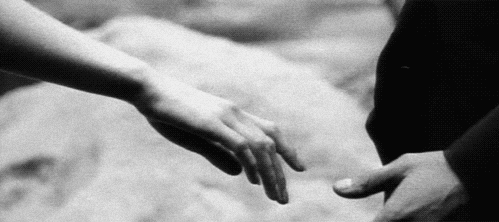
[ Post season 3 / no smut (but allusion to it?) / fluff / established relationship ]
Contents: Din Djarin’s wife finds out that naming conventions on Aq Vetina aren’t the same as Mandalore.
Notes: based almost entirely on the works & verse established between myself & the incredible @joelsgirl . Couldn’t ask for a better writing buddy & friend 💜
——
Nyssa has lost count of how long exactly she’s been with him. Long enough that she knows beyond a doubt that he’s her person. That anyone else in the galaxy could want her and she’d be blind to them, because for her, there’s nobody else.
Originally she had meant to be nothing more than a bounty, a quick way to make some credits. A mouthy droid mechanic that he’d picked up on Tatooine but gotten inexplicably attached to.
They could have gone their separate ways, but she had chosen him, just as much as he had chosen her. She would always choose him.
The day he put the beskar choker around her throat - engraved with the symbol of his clan, the Mandalorian equivalent of a wedding ring - she felt like she could finally breathe. Like she could exhale a breath she didn’t know she had been holding, finally secure in knowing that she meant as much to him as he did to her.
She hasn’t taken it off since. While she’s an outsider, unbound by the Creed, the necklace marks her as one of them. Part of his clan. His family.
Him, her, and the kid. She knows Grogu won’t be their only child, knows this like she knows the sound of his boots approaching, knows her own name, knows the sound of their hearts pounding together late at night.
Which is why she currently feels like an absolute bonehead.
It’s been eating away at her for a few days now, since they settled into the house on Nevarro. The way the Armourer named her, named Grogu. Not as Vanyssa and Grogu Djarin, but as Din Vanyssa, Din Grogu.
The absolute shame when she realised that all this time, she’s been his wife, and she hasn’t even been using his name right.
“Why didn’t you tell me I was using your family name?” She peers down at him; he’s sitting on the bench on the porch, had been considering whittling a piece of wood into a flute before she came out to speak to him.
It’s nice to see him without his helmet on, though it’s sitting beside him in case they have unexpected company. By the laws of his religion, only her and his children can see his face.
He turns his head slightly to look at her, expression blank.
“What do you mean?”
“All this time, I’ve been calling you Din, but that’s your family name, right?” Nyssa turns red, ashamed that she didn’t ever realise.
He gives her a half shrug, gets to his feet. He doesn’t want her upset over it, it really isn’t that big of a deal to him.
“Does it matter? Everyone gets it round the wrong way. Mandalorians - born Mandalorians - go first name then last name.”
“But your birth culture doesn’t.” It’s a statement, not a question.
“No. On Aq Vetina, the family name goes first. Even though in every sense of the word I adopted the Mandalorian culture, values and Creed, I kept the naming convention of my home world.”
“I feel like an ass.”
“Why? I never bothered to correct you. Few enough people know my name as it is. What’s it matter if they get the order wrong?”
“It doesn’t bother you?”
He shrugs again. “A name is a name.”
Nyssa crosses her arms.
“I’m your wife. I’m supposed to know these things.” As she says it, though, she’s starting to get the idea that maybe he’s not as bothered by this as she is.
He’s used to living in societies where the naming convention goes first name then last name, not the other way round. That without him bothering to correct her, how would she know?
He looks at her with that same unreadable expression for a moment before the faintest hint of a smirk crosses his face, hands rubbing her shoulders in a comforting gesture.
“Frankly, I don’t care which of my names you use. Half the time, you call me daddy anyway, so…”
Nyssa sputters, cheeks going red. He watches her, amused by her embarrassment.
“Truly, though, love. It doesn’t matter. You know now.”
Wrapping his arms around her, he pulls her nice and close, leans down to kiss her.
Immediately she loops her arms around his shoulders, one hand settling in his hair as she leans into the kiss.
“You know… about that daddy thing…”
He freezes, stares at her in complete shock.
“Are you-?”
She gives him the smallest, shyest smile that is so unlike her usual confidence that it almost melts him.
“I hope the house is big enough for a clan of four…”
He says nothing, leans down to kiss her again, soft and gentle and loving. Damn, guess the work on the house can’t wait after all.
#my writing#din djarin fluff#the mandalorian#the mandalorian fic#din djarin x oc#din djarin fic#din djarin#din grogu#Vanyssa Ka’tar#technically can also be tagged as#din vanyssa#tagged: dinyssa#pedro pascal character fic#pedro pascal
55 notes
·
View notes
Photo
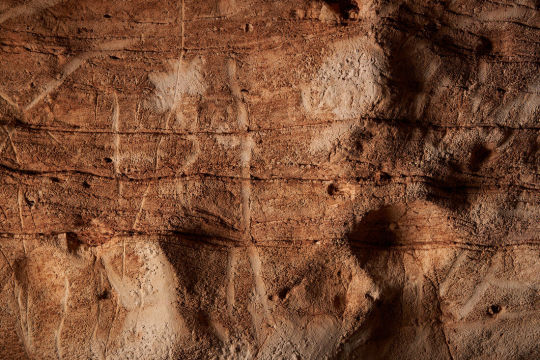
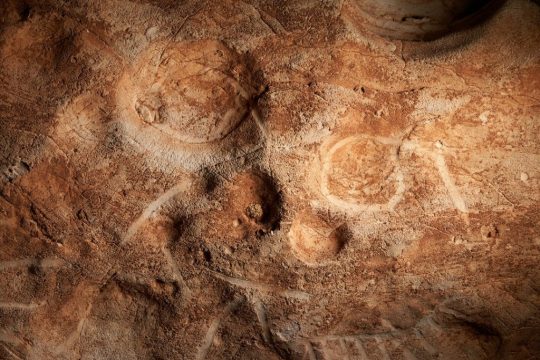



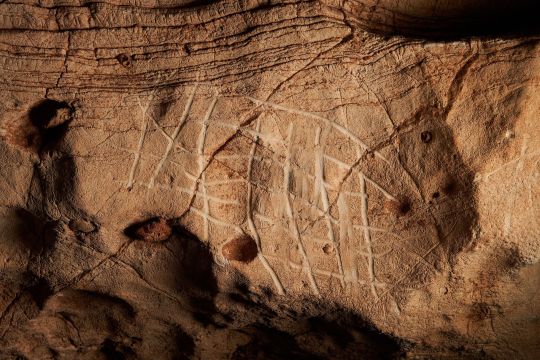
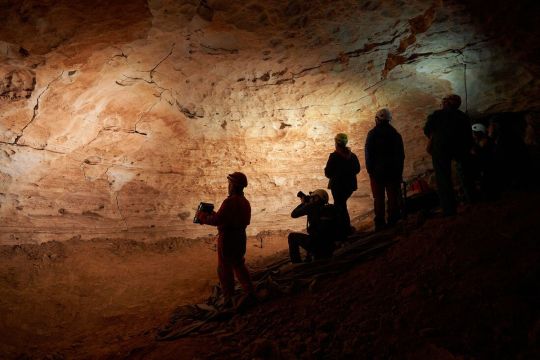
Preserved Prehistoric Engravings Found in Spain
Significant prehistoric rock art has been discovered in La Febro, in southwestern Catalonia.
The team that discovered the art inside Cova de la Vila described it as “exceptional, both for its singularity and excellent state of conservation.”
In the Cova de la Vila cave in La Febró (Tarragona), in northeastern Spain’s region of Catalonia, more than 100 prehistoric engravings have been found, arranged on an eight-meter panel.
According to experts, it is a composition related to the worldview of agricultural societies and farmers of the territory. One of the singularities of this mural is that it is made exclusively with the engraving technique, with stone or wood tools.
The engravings include shapes that resemble horses, cows, suns, and stars.
Julio Serrano, Montserrat Roca, and Francesc Rubinat were the cavers responsible for the discovery; they collaborated with Josep Vallverd, Antonio Rodrguez-Hidalgo, and Diego Lombao, researchers from the Catalan Institute of Human Paleoecology and Social Evolution (IPHES-CERCA), and Ramón Vias, an expert in prehistoric rock art.
It was in May 2021, during some scans and topographical work by a group of speleologists in the Barranc de la Cova del Corral, that they discovered the Cova de la Vila, a cavity excavated by Salvador Vilaseca in the 1940s and whose coordinates appear to have been lost.
The set is very homogeneous stylistically and presents few overlaps. From the stylistic point of view, the set is part of the post-Paleolithic schematic art. It is an art associated with peasant and livestock communities during the transition period between the Chalcolithic and the Bronze Age, that is, between 5,000 and 3,000 years BC. In Catalonia, these types of ensembles, in underground cavities, are very rare, being the case of the Sala dels Gravats of the karstic complex of Cova de la Vila exceptional for being inside a cave and possibly associated with an archaeological context.
These types of representations are uncommon in Catalan territory, though some examples can be found, such as the Vallmajor Cave in Albinyana, Baix Penedès. In the peninsular area, it would be classified as “underground black schematic and abstract schematic,” which are heterogeneous groups distinguished by their formal or typological, thematic, and technical affinities. La Pileta and Nerja in Málaga, La Murcielaguina in Córdoba, and the Los Enebralejos caves in Segovia, the Galera del Flex in Burgos, or the Maja Cave in Soria are some Andalusian caves with painted (black or red) or engraved representations and similar chronologies.
The engravings are in exceptional condition, but they are extremely fragile due to the instability of the support on which they are found. Because it is a soft and humid surface, changes in the atmospheric conditions in the room may affect the conservation of the panel.
To ensure these climatic conditions, the Department of Culture, the Febró Town Hall, and the IPHES collaborated to close it both outside and inside, ensuring its physical conservation. Similarly, a closure has been installed in the access to the cat flap, which provides direct access to the Sala dels Gravats, to return it to the climatic conditions it had prior to discovery.
A unique set of engravings
The rock art collection of the Sala dels Gravats of the Cova de la Vila karstic complex is completely unique. Despite the fact that its research phase has not yet begun, all indications point to it being one of the best compositions of post-paleolithic subterranean abstract art in the entire Mediterranean region.
On one of the cave walls, a large number of schematic representations have been discovered. The engraving panel is made up of five horizontal lines, one on top of the other, with different engraved figures that each have their own meaning and symbolism.
Various figures such as quadrupeds, zigzags, linear, angular strokes, and circles are represented. There are several zoomorphs (possibly bovids and equines), steliforms (single and/or stars), and reticulates that stand out. There’s also a composition that looks like an ‘eyeballed’ idol. The overall aesthetic is very consistent, with few stylistic overlaps.
The distribution of the various elements suggests that it could be a composition: zoomorphic in the lower part of the panel, reticulated, particularly in the central part, and steliform in the upper part of the group, with an eye in the upper part of the group.
By Leman Altuntaş.
#Preserved Prehistoric Engravings found in Spain#Catalonia Spain#Cova de la Vila#prehistoric rock art#ancient art#ancient artifacts#archeology#archeolgst#history#history news#ancient history#ancient culture#ancient civilizations#long reads
36 notes
·
View notes
Text
April showers bring May flowers… and the end of April brings a close to poetry month. A story can be told in various forms, through verse, prose, epistolary, and solely through images. Illustrations can give visuals for difficult literary imagery or they can be the sole narrative form of a work.
The James Smith Noel Collection is currently displaying various works of poetry featured from Homer to E.E. Cummings. Some of these publications have marvelous illustrations and etchings that provide readers with deeper understanding of literature. In the case of one particular work, we are showing an edition of Beowulf which is an epic poem. Beowulf holds a special place in literature and in English history, since it was one of the earliest recorded poetical works of the English language. While this edition has been translated from its original old English for easier reading, it is also an illustrated edition. The epic poem has been translated and adapted numerous times over. This particular edition is from the late 1930s and is illustrated with woodblock prints in a blended style of Art Deco and Expressionist.
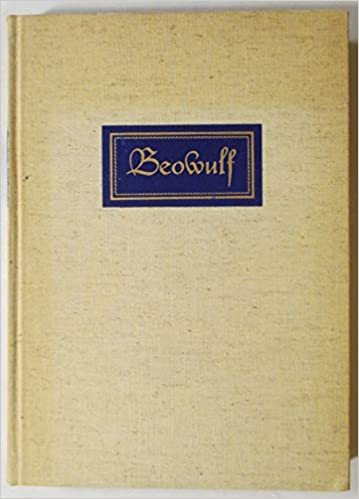

The artist for this edition is Lynd Ward who lived from 1905 to 1985 and he was an American artist and novelist. He was known for his series of wordless novels for juveniles and adults that would influence the creation of the graphic novel. His print works included more than just woodblock prints but also used watercolors, oil, ink, lithography, and mezzotint. He suffered from tuberculosis in his early life and throughout much of his childhood. He took to drawing and art from an early age; and it is said that he told a teacher that “Ward was draw spelled backwards.” When he was in high school he was the art editor for the school paper and yearbook where he was exposed to linoleum-block printing. He remained dedicated to art and studied at Columbia Teachers College in New York. After graduating he went to Europe and attended the National Academy of Graphic Art and Bookmaking in Germany as a special-one-year student. He learned etching, lithography and wood engraving. Ward learned wood engraving from Han Alexander “Theodore” Muller, and was deeply influenced by Muller. It was during that time in Leipzig, Germany that he encountered two wordless novels, one by the Flemish artist, Frans Masreel and the other by Otto Nuckel. Masereel’s wordless novel The Sun (1919) featured a story told through 63 woodcut illustrations. Otto Nuckel’s Destiny (1926) which was illustrated with lead-cut engravings with a darker and naturalist narrative.
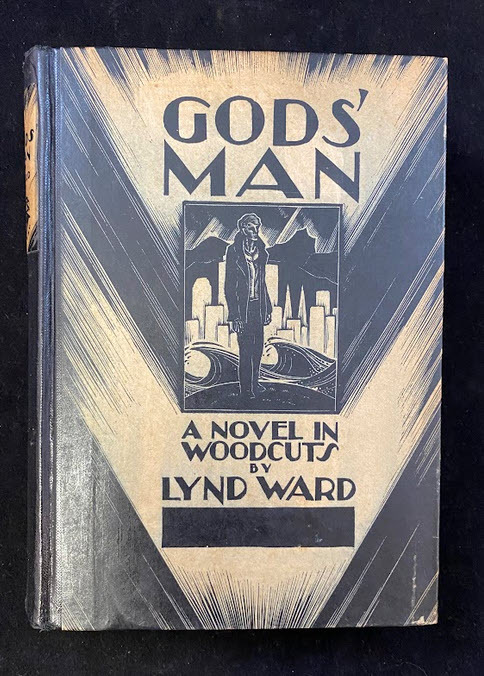
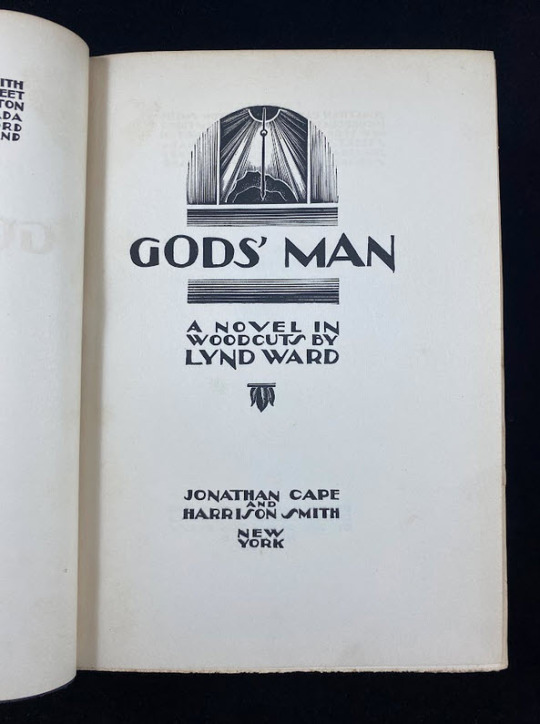
Ward returned to the states in the autumn of 1927 and showed his portfolio to a number of editors, was commissioned by Dorothy Rowe in 1928 to illustrate The Begging Deer: and other stories of Japanese Children. Ward illustrated several other works until 1929 when he created his first woodcut illustrated novel and the first American wordless novel, Gods’ Man in October of 1929. The James Smith Noel Collection also holds a copy of Ward’s novel Gods’ Man (https://bit.ly/42lQhrB).



The illustrator for our 1939 edition of Beowulf is not the only interesting contributor to the literary canon, the translator for this edition is William Ellery Leonard. William Ellery Channing Leonard was born in 1876 to parents that admired the transcendental literary movement. He was named after the mentor of Ralph Waldo Emerson, William Ellery Channing. Leonard had an nontraditional education, attending as a student in his mother’s class for 5 years and then home-schooled by his father until the age of nine. He took up a job as a door-to-door salesman out of high school due to frustrations at not being able to afford college to further his passion for literature. By happenstance, he accidentally ended up at the College of Liberal Arts at Boston University when seeking to visit the Massachusetts Genealogical Society because his guidebook had the wrong address. The venture resulted with Leonard being offered a tuition scholarship from the dean of the college. He would go on to write over 200 poems while in school and publish in Century Magazine in 1899. He graduated with a B.A. from Boston University and then moved on to Harvard University for a masters. He completed his masters in a year and a temporary professorship. He maintained a successful education and literary career, he also produced numerous volumes of poetry.
Leonard spent his life struggling with agoraphobia, which resulted in decreasing radius until he would host academic lectures in his home. He was briefly married to the daughter of his landlord and then later to a student. His personal struggles are reflected in his poetry. His death was commented on by a newspaper as being what freed him from his “phobic prison.”
Leonard also wrote scholarly commentaries on Aespo, Empedocles, Luretius, and Beowulf. The edition on display in the James Smith Noel Collection is fully titled as Beowulf: translated into verse by William Ellery Leonard and illustrated by Lynd Ward (https://bit.ly/41KZvNU) published by Heritage Press in 1939. The edition is illustrated with black, blue and light-brown woodcut prints, the illustration on display for the J.S. Noel Collection’s current exhibit is of when Beowulf is battling the sea-hag or water-witch that was Grendel’s mother in an underwater cavern. The Danish-hero struggles against foe and then finds a sword at the bottom of the cavern, the sword is the key weapon for defeating Grendel’s mother.

21 notes
·
View notes
Text

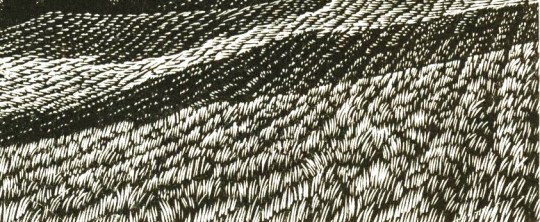
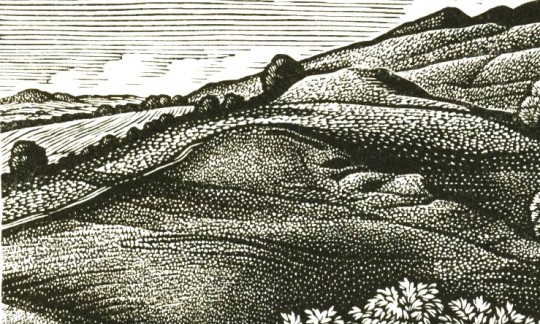
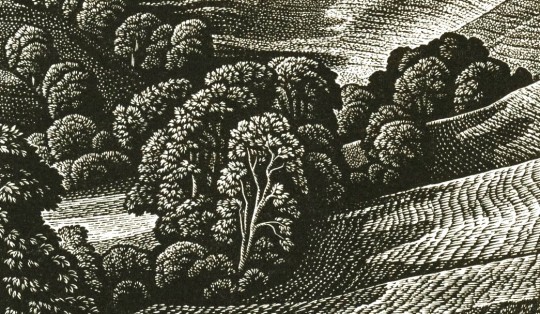
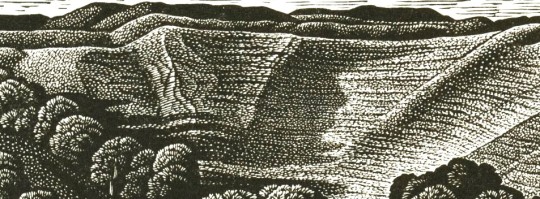
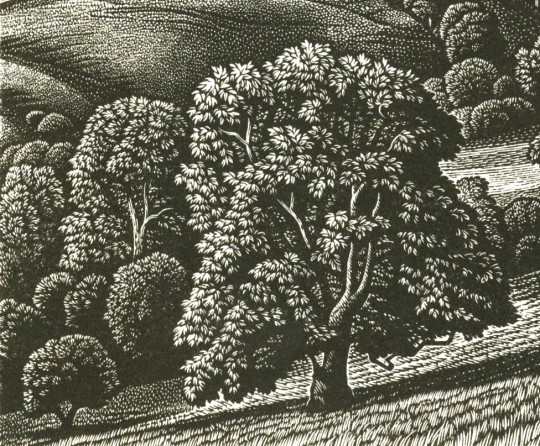
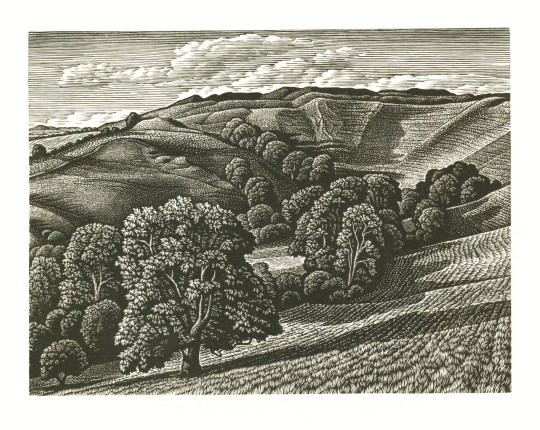
Wood Engraving Wednesday
HOWARD PHIPPS
This wood engraving of Eggardon Hill in Dorset, England by British artist Howard Phipps (b. 1954) was produced in 2019 for the publication 2020 Vision: Nineteen Wood Engravers, One Collector, and the Artists Who Inspired Them, printed in 2020 by Patrick Randle’s Nomad Letterpress at the Whittington Press in Cheltenham, Gloucestershire, in an edition of 340 copies for the 100th anniversary of the Society of Wood Engravers. In the book, Phipps identifies Edgar Degas, John Nash, and Eric Ravilious as strong influences. Phipps himself started off as a painter in the 1970s, making only occasional prints. His development as an engraver coincided with the revival of the Society of Wood Engravers in the 1980s. About this print, he writes:
I was interested in the ancient signs of humanity apparent in this landscape, and I like to use light to reveal the underlying sculpture of the striking hill forms, where chalk trackways draw the eye into or around deep combes.
Phipps was born in Colwyn Bay, North Wales and was raised in Cheltenham, England. He studied Fine Art at Gloucestershire College of Art in the early 1970s and taught in Plymouth for a while before settling in Salisbury in 1980. He was elected Royal West of England Academy (RWA) Academician in 1979 and a member of the Society of Wood Engravers in 1985.
View other posts with work by Howard Phipps.
View other posts from 2020 Vision.
View more posts with wood engravings!
#Wood Engraving Wednesday#wood engravings#wood engravers#Howard Phipps#Eggardon Hill#2020 Vision#Nomad Press#Whittington Press#Patrick Randle#Society of Wood Engravers#letterpress printing#fine press books#artistic influennces
122 notes
·
View notes
Text



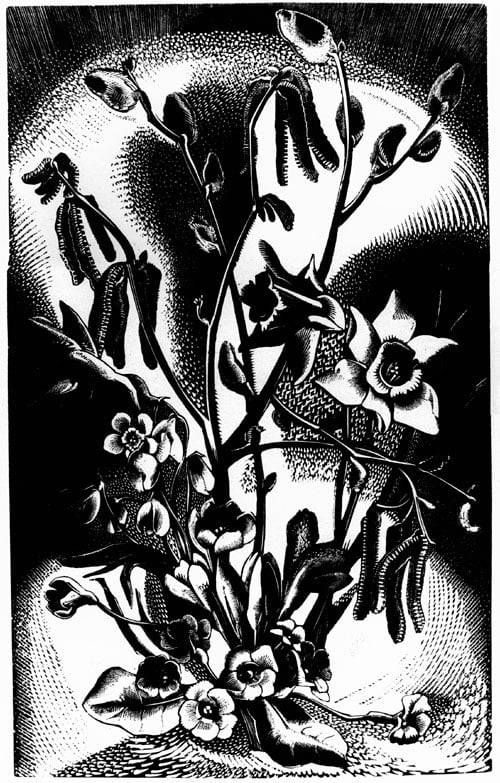
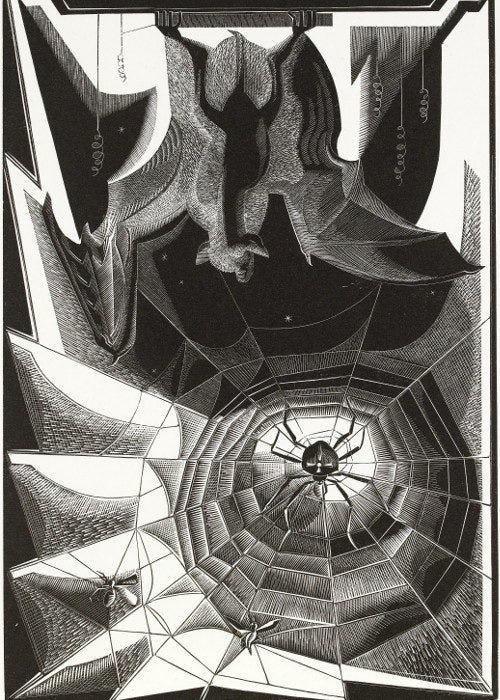



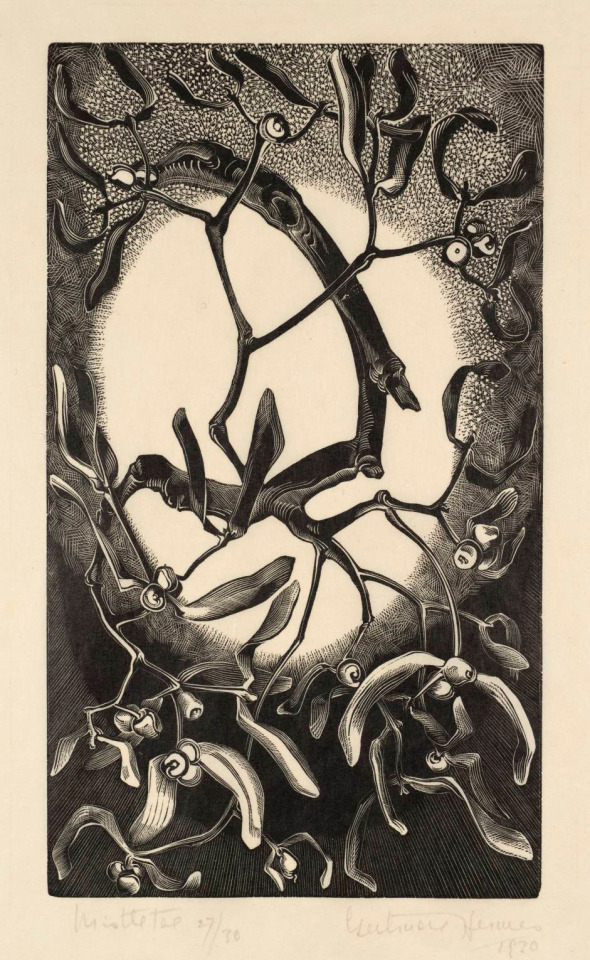


Gertrude Anna Bertha Hermes (1901 – 1983) was a British wood-engraver and sculptor. Hermes was a member of the English Wood Engraving Society (1925–31) and exhibited with the Society of Wood Engravers, the Royal Academy and The London Group during the 1930s.
"Hermes was an understated rebel – she never wanted to be commercial or sell works for large amounts of money – in fact, many of her pieces were simply given as gifts to friends and family. Yet, her most empowering act was a critical turning point in both art and equality, was when she demanded that the Royal Academy, of which she was a member, to allow women to attend the dinner after the Annual General Meeting of Academicians. The following year, Hermes and Barbara Hepworth both sat pride of place." https://www.anothermag.com/.../wild-girl-the-artistic...
25 notes
·
View notes
Text

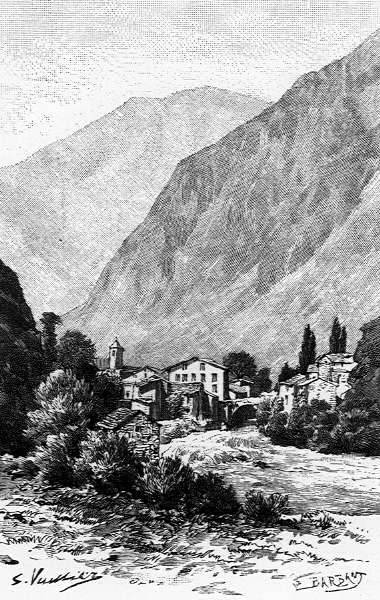




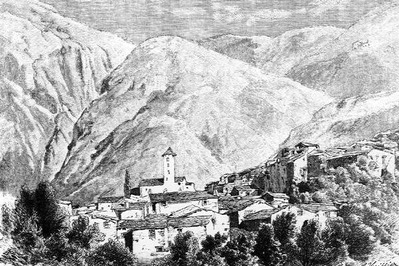
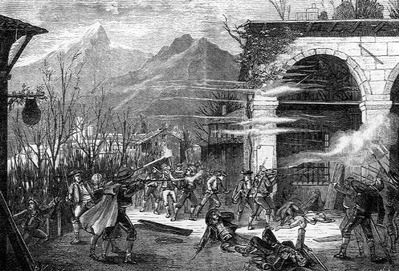

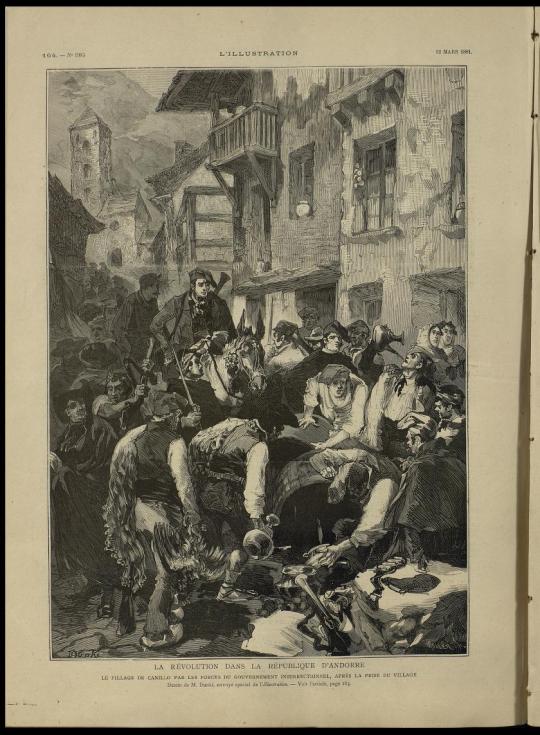
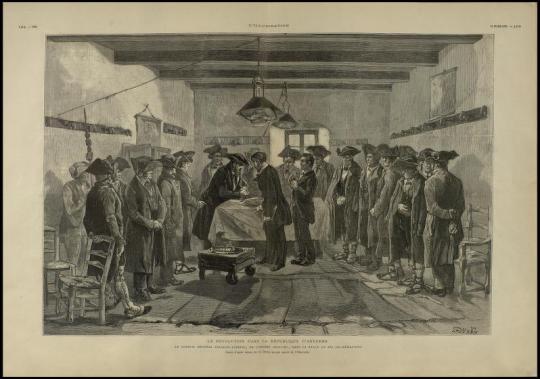
Engravings published by the French newspaper L'Illustration covering the 1881 Andorran Revolution.
Before the widespread use of photography in newspapers, they would use woodcut printing: carving an image out of a piece of wood and applying ink to the relief pattern of the piece to engrave the image onto a surface. These ones were published March 12th 1881.
Many people say they don't understand Andorra. Some say this microstate was in feudalism until the 1993 because of the power of some families, and they amaze at their jump from that to the 3rd sector economy they have now. The coexistance of 3 different schooling systems, or the way that France and Spain carry out some of the services are also disconcerting. The Andorran Revolution of 1881 helps us understand how Andorra placed their hopes in the tourism service industry and how it shaped what it's like nowadays.
Read about the Andorran Revolution and its consequences under the cut.
In the 19th century, many countries in Europe became industrialized. The Industrial Revolution did not happen in small rural Andorra, but it did in the nearby Catalonia. As a result, the Andorran economy crumbled: the lower class often made a living with jobs related to making clothes or forging metal, but these were not viable anymore. The attempts to start factories in Andorra failed because of the difficulties of transport, considering that Andorra is a country nested in the Pyrenee mountains and is not easy to access. The only jobs that still could work was smuggling, but France and Spain were trying to stop it. At the same time, the population was falling due to the deaths of cholera and yellow fever, with a very significant amount of children's death, affecting even the rich families.
Every time more people in Andorra wanted a change in society and economy. Remember that in the 19th century, Andorra still had an Old Regime system based on two estates, where only the men of the upper estate (about 3% of the population) could participate in Government or vote. But at the same time, there were also people of the lower estate who had become wealthy as a result of their jobs or smuggling, but still were not allowed to take part in politics. Above the Government, there were the two co-princes (the Bishop of Urgell and the King of France).
Step 1: "Revolution from above"
As expected, the Government formed by the upper estate men did not make any changes. As a response, rich lower estate Andorrans (section called "progressives" or "reformists") made a list of reforms that they wanted the co-princes to sign, since they're more powerful than the Government. These were their demands:
Every house leader (father of the family) has a right to vote, no differences. (This eliminates the estates system)
Create "the people's commissioner": a government official in charge of controlling the administration and common money
Half of the Parliament and the Government must have elections every 2 years
The same person cannot be general councillor (president of Andorra) and mayor or councillor of a town council.
Limit how many councillors in the Andorran government can be from each town.
A person can't occupy one government role for more than 4 years.
Three years later, the king Napoleon III signed it, but it did not improve the economy. The change came when people started renting their houses, starting the early "hotels" and spas in the thermal waters. For this reason, Andorra looked at Monaco: when France banned gambling, Monaco opened many casinos and became rich making the European rich families spend their money in Monegasque casinos. However, Andorra wasn't rich enough to open casinos, spas, nor roads leading to the country (the only option was to come by mule or horse). They tried to get a French bank involved, but the co-princes banned building the casinos as soon as they found out.
Andorran people had their hopes in the building of those casinos and spas, but the "progressive"/"reformist" side did not dare to protest the co-princes' decision, because they feared they would lose the rights they had recently gained.
Step 2: "Revolution from below"
The lower class took the matter in their own hands. They armed themselves, with support from gambling companies, and started a Revolution that lasted from December 1880 until June 1881. They overthrew the Government and substituted it for the Provisional Revolutionary Council. Their first decision was to give a foreign company the right to build casinos and spas.
The co-princes blocked the borders with France and Spain, and in the end the members of the Provisional Revolutionary Council were arrested.
Representatives of the revolutionaries and the counter-revolutionaries reached the Treaty of Pont dels Escalls, that declared an amnesty for Andorrans of both sides and new elections. The elections went as planned, but the co-princes didn't accept the amnesty and many revolutionaries were sentenced to prison or exile. The co-princes also banned gambling in Andorra, a prohibition that lasted until Andorra's Constitution in 1993.
How this shapes modern Andorra
As you have seen, since the late 19th century, Andorra skipped industrialization and went directly to the third sector, focused on spas and tourism, which are still among the most important factors in the Andorran economy nowadays, together with being a tax haven.
After the revolution, both France and Spain tried to annex Andorra, a conflict known as "the Andorran Question". Facing the pressure from France and Spain, Andorrans began feeling the need to reassure their identity: for the first time, Andorrans didn't only identify as Catalans, they felt as Andorrans, and they stated that their nation is Andorra.
One of the ways in which Spain and France fought was introducing French and Catholic Spanish schools in order to make Andorrans speak those languages and indoctrinate them to side with that state. Nowadays, Andorra still has three school systems: the French one, the Spanish one, and the Andorran one (created in 1982).
About the engravings
The engravings in this post represent different landscapes of Andorra (on the cover: Casa de la Vall, Andorra's government building; 2nd photo: Les Escaldes; 3rd: Andorra la Vella; 4th: Sant Julià de Lòria; 6th: Encamp and the Valira river; 7th: Canillo), a man and a woman wearing Andorran clothes (5th), a scene of the revolution (8th), the Courts tribunal of the Andorran Republic (9th), the pillaging of Canillo by the forces of the insurrectionary government after the siege of the village (10th, click for full picture), and the Revolutionary Council in official uniform in the deliberation room (11th).
Photo sources: Andorra Antiga and Library of Congress.
#andorra#història#qüestió d'andorra#revolution#history#europe#european history#19th century#1800s#industrial revolution#spanish history#french history#france#spain#engraving#l'illustration
10 notes
·
View notes
Text






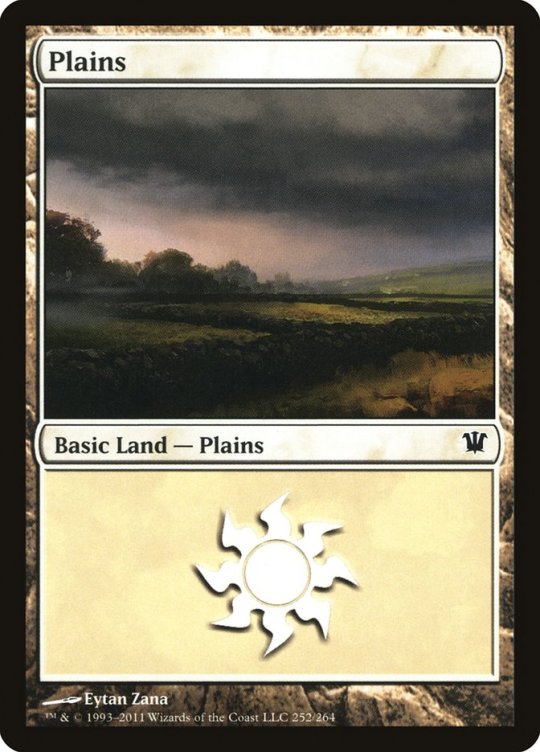


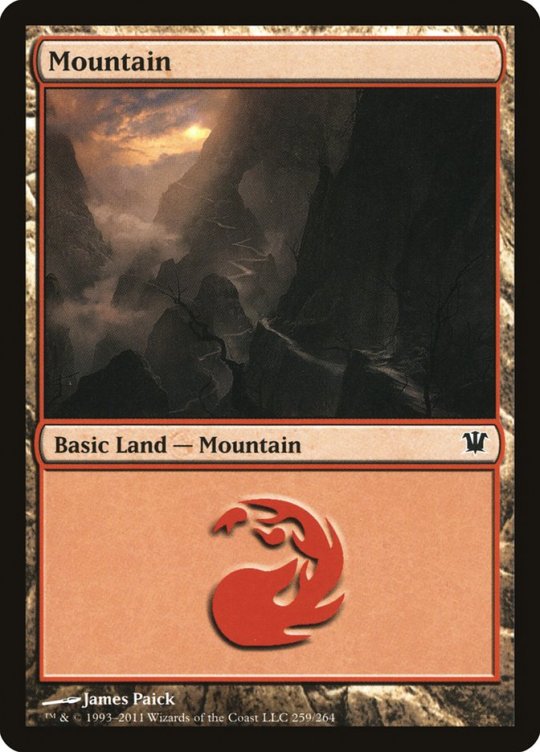
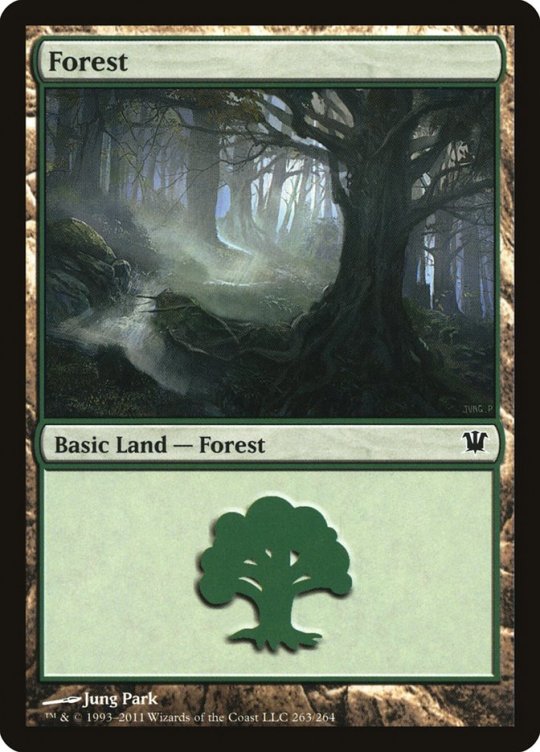


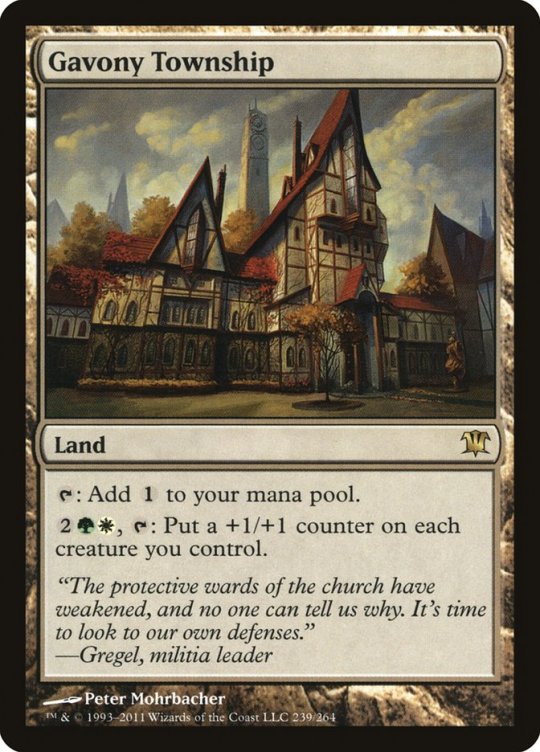
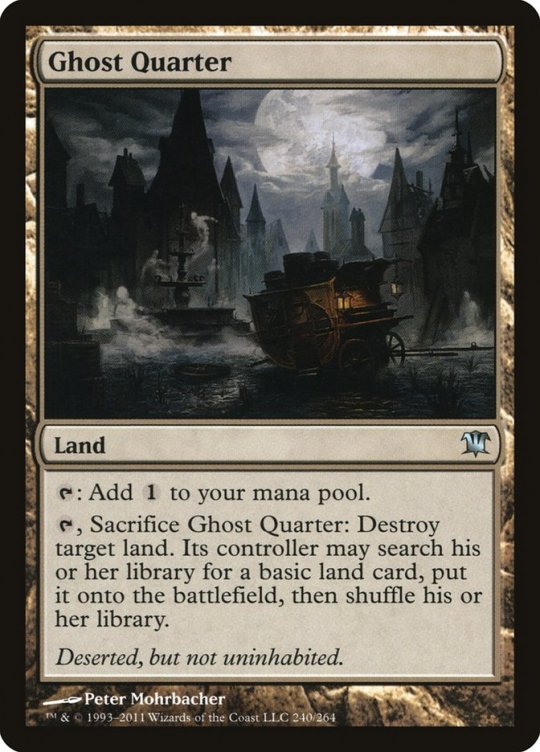
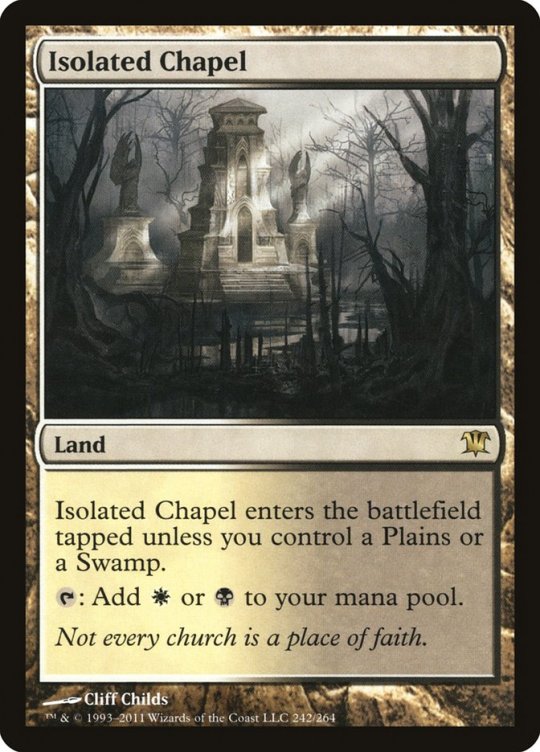
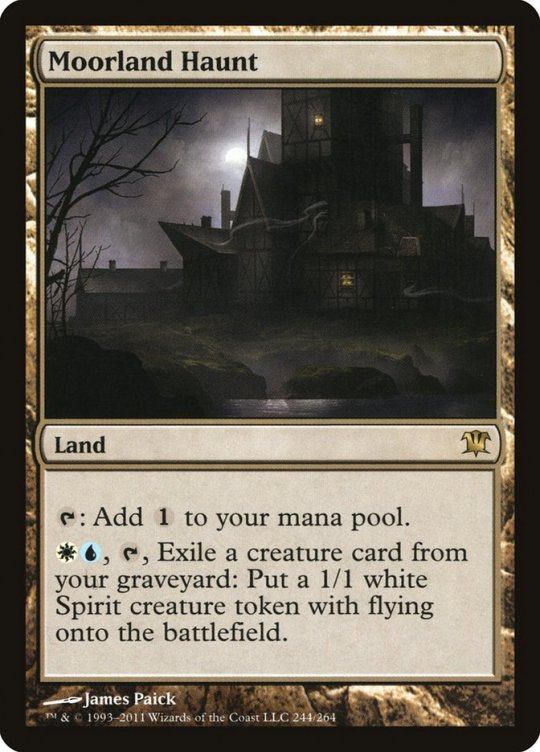
Magic the Gathering: Innistrad (Innistrad block)
My favorite Land cards
The plane of Innistrad is divided in four great regions, called the "Provinces".
The first province, Gavony, is the "safest" area for humans in Innistra, and thus the province with the highest number of humans. Gavony is home to Thraben, the High City. Ah, Thraben! The largest city of the continent. The center of the Church of Avacyn. A fortress built to resist all supernatural attacks. It is here that Avacyn the Archangel once resided, wthin Thraben's Great Cathedral, and the city is located on the mesa of a lake known as the "Lake of the Herons" (in Innistrad, herons are believed to the the birds of the moon, and by extension symbolize goodness and Avacyn's power). At the northern edge of Gavony, Thraben is a city of cleanliness and order, inhabited mostly by clerics, merchants and artisans. Everything is neatly divided and organized within the city, usually in ways reflecting the social order. Take the Great Cathedral. During worship, it divides itself in three parts: the Chapel of Noble Peers (opulent, gilded chapel for high-level clergymen and nobility) ; Midvast Hall (larger and less opulent hall, for ordained people and the lesser clergy) ; Common Cloisters (covered corridors alongside Midvast Hall, where commoners stand during worship). The divisions extends to the numerous walls that surround Thraben - some old, some recent, some well-kept, some in ruins, some great, some small, they form a complex interwoven puzzle. There are five main walls: the Outer Wall (main defense of the city, thick and high wall that has been several time expanded to avoid the overcrowding of the city) ; the Merchant's Wall (a series of halls that acts as the market square and commerce-center in the city) ; the Bloodless Wall (a prison for vampires, where they are chained to the wall and left to starve to death) ; the Fang Wall (an execution ground for werewolves, their fangs are embedded between the stones of the wall) ; and the Child's Wall (Thraben's oldest wall, surrounding the Old Cathedral, with the name of every child born in Innistrad engraved on it - it is a pilgrimage site for new parents, who believe having their child's name on the wall expands their life).
From Thraben, all sorts of "smaller towns radiate outward", throughout Gavony's rocky moors, and rolling hills and heaths, dotted with "small copses of trees". Safety is the main concern and currency in Gavony: the rich, wealthy and powerful live comfortably within fortified manors, while the poor spend all of their money on talismans, magic wards and blessings of the Church (because the Church does ask for a bit of money in exchange of their heavenly power). And while there is a growing resentment towards the Church's greed and self-centeredness (the higher ups of the Church, with sheltered and comfortable lives, tend to not understand the harshness of the rest of the continent), there is still a very strong sense of community within humanity in the province, and the Church stays the basis of human society. As the Guide to Gavony explains: the basic social unit of Gavony is a parish, organized around a local chapel, and they can be as tight as clans. In Innistrad, the Church is the State and the State is the Church: judges and lawyers are ordained by the Church, and in return the Church keeps confirming and supporting the rule of the law. All education across Innistrad is the domain of the Church. Merchants and artisans are the only jobs that are technically free and independant from the Church, but even them have to respect the Church, because their guilds and organizations (called "fellowships" have to be sanctioned by the Church.
Unfortunately, having a high population of humans also means Gavony has the largest numbers of cemeteries across Innistrad - which also means more undeads and more geists than elsewhere on the continent.
The second province is Kessig, the "vast, wooded hinterland" of Innistrad. It is said that autumn is perpetual within these deep woods, for the green constantly mixes itself with golds and muted reds ; and at night, under the moonlight, everything become "stark and steel-like". Humans carved themselves farming villages and rolling farmlands within the dense, dark woods ; and if they are not farmers, they will be hunters and trappers. But everybody knows that it is a suicidal act than to venture in the woods at night: Ulvenwald, the misty woods, are haunted by both ghosts and werewolves. Ulvenald is almost "supernaturally dense" - no normal wood can have so much aspen, birch and maple trees growing in such a dark, sinuous and compact ensemble. Travellers of the forest at best will be haunted or attacked by spirits and beasts - at worst, they will mysteriously disappear in the mist.
The humans who live in Kessig have a life strongly focused on work. You need to work to survive: Kessigers learned to be self-reliant, pragmatic and plainspoken. They are farmers, millers, weavers and stonemasons: they don't purchase their tools, they do it themselves ; they do not learn mathematics or history, they learn the harvest cycles and the edible weeds. They are hard-headed and unpretentious - and are part of Avacyn's religion in their own way. They do not trust the cathars (holy warriors) of the big cities ; they do not like the Gavony ghost-hunters who are too pritine and shiny ; they do not understand the decrees of the aristocrats of the High City of Thraben... But they believe in Avacyn with all their heart, and their motto is: "The worked earth below us, the hand-hewn stone walls around us, and the angel above us". This is their world. Given superstition and fear rules in Kessig, it is polite when you meet someone for the first time to show that you wear an item made of silver (unfortunately there is a lot of "counterfeit" silver going around, especially sold at Nephalia). Wreaths of living wood are a common gift, and are placed on the door of homes where a child was just born. Before going onto a journey, people either fast up to a whole day, or eat sour root soup : it is believed it makes humans less appealing for werewolves and hungry beasts. To be fat and well-fed in Kessig is to become an easy prey. A local tradition in Kessig is the "Sleep Revel". On the anniversary of a person's death, they are celebrated - or rather, one successful year stayed in the ground is celebrated. The "undisturbed sleep of one's ancestors is seen as almost a greater blessing than the continuing birthdays of one's living relatives".
The werewolves are the main dangers in Kessig, because they haunt the woods in packs or as lone wolves. It is known that the "howlpacks" as they are called wane and waxe with the moon, and that many werewolves live secretly among Kessigers (causing a lot of suspicion and speculation among Kessig's human communities). Add to that the fact nobody agrees on how to detect, hunt or cure werewolves - let's just say persecution and prejudice can run rampant around. Kessig is also a land plagued by geists - but not "regular" geists like other provinces, oh no! These are green-aligned geists, that is to say not ghosts of the living, but wild spirits of nature opposing the civilized life. Mischievous poltergeists, blood mists that devour the living, surreal fires that burn of a cold flame, beautiful nature spirits of vine and thorn, feral possessed beasts... Due to the omnipresence of werewolves and nature spirits, most of the other supernatural threats are banished, but it doesn't mean they are not absent... For example, at the foot of tall stone hills, a smoking and boiling fissure called the "Devil's Breach" is known to cause minor and sporadic demonic activity.
Trivia: Due to not having much around, Kessigers consider zombies as symbols of the "evils of the big city", and in their mind they associate and equate "necromantic alchemy" with all the other vices of "big cities": murderous conspiracies, black market, religious heresy, and prostitution.
I will place the two other provinces under the cut:
The third province is Stensia, which is fully and completely under the control of vampires. Stensia is known as the "darkest" part of Innistrad, figuratively and literaly. The sun never manages to fully shines beyond Stensia's perpetual cover of oddly-colored clouds - only the light of the moon can truly appear. It is a very mountainous area dominated by the "Geier Reach", a mountain chain of impossibly high peaks of indigo and black rocks. The forests there are of evergreen, forested midlands of black pine "riddled with whisps of thick fog". The mountains split the region into two distinctive valleys with a dusky pastoral charm, and two distinctive bogs, where old graves and dead conifers slowly sink. The mountains also separate the wary human villages inhabited by fearful, if not paranoid humans, who stay however loyal to their land and passionate about their lifestyle ; from the vampire manors and the blood-thirsty rulers of the region. Right in the middle of the mountains, you can find Ashmouth, a deep chasm glowing with magma at the bottom - and a literal gateway to Hell...
Stensia is divided between "human culture" and "vampire culture". The human villages are prepared for vampire attacks: they are all circled by moats (that vampires cannot cross when the moon is out), and they have nearby hawthorn tree groves to keep access to "living wood". Large cottages and rich people place mirrors on their frontdoors, and build their house near a hawhthorn tree, that the eldest child of the family must care for. Due to the rocky soil and dim light of the region, Stensia humans are not farmers, but relies on sheep for their woll, milk, leather and meat - Stensian wool is said to be the finest of all Innistrad, and thanks to the vampires' presence, werewolves do not haunt the area. Generations of seeing their children and neighbors die, and of living near the vampire threat, made humans stoic, non-expressive and non-demonstrative. They are proud and fervent, but will seem rude, violent and cold to outsiders.
Vampires meanwhile, are self-centered narcissists who believe themselves the guardians and "shepherds" of humanity, and that the sacrifice of their humanity is somehow something humans should "honor". Vampires are basically the most decadent nobility you will ever find, living in days of feasts, balls and parties, keeping all sorts of grudges and organizing betrayals just to amuse themselves, demanding the finest and most luxurious items for themselves. Olivia Voldaren, a prominent vampire of the area (I posted her card in the Multicolor section), invented a disturbing three-days feast called "The Court of the Vampire King/Queen". The principle is simple: kidnap a human being, bring him to the greatest gathering of vampires of Stensia, and name them "King of the Vampires" or "Queen of the Vampires". This is a vampire's Carnival or Feast of Fools: the mock-queen is served the best foods and drinks, entertained by all sorts of shows, and the vampires around must obey the human's every command (except those of making the ruler "abdicate"). At the end of the three days of party, the human is killed and their blood shared among all the revelers.
The last province is Nephalia, the coastal side of Innistrad. Nephalia is the watery region of the continent - nearly treeless, it faces the foggy and dark sea of Innistrad, and all the rivers of the inland end up here, creating all srots of deltas, marshes and bogs. The beach is made of a silvery sand, the towns are all here small or medium-sized ports, and the region is filled by a system of tunnels, underground pathways and sea-caves known as the Erdwal or "The Ditch". It was originally a set of trenches between the three main towns to resist zombie and werewolf attacks. Then it became a "network of defensible walkways" to transport the goods and ensure the trades in a region filled with hungry zombies, angry geists and demons. Merchants turned this system into the true "artery of trade", and then a "bustling underground economy" appeared within it, "in all manner of grey and black market goods". On the Erdwall you can buy assassins, human blood, curses, necromancy spells... It is a "trench marketplace of colorful rogues, seedy merchants, filfthy sailors and gaunt stangers, all doing business in dark alleyways and roughly hewn tunnels branching off the main trench". Alchemists, skaberen and ghoulcallers have a notably active presence there - selling human blood, buying pieces of corpses for their flesh golems, dealing with transmutation of base metals into pure silver... Sometimes a "defective" creation of a skaberen can get loose and slaughter all those in the tunnels. Nephalia managed to create a cold "understanding" and an uneasy "truce" with the Church of Avacyn - as long as those dark dealings happen below the ground, the Church won't do anything. This is why it is commonly said that "sloughs, sea mists and mysteries cloak Nephalia's commerce and crimes".
Nephalia is notorious for being the most "mixed" province in terms of population. Human, geists and vampires alike haunt the region, seeking business, secrets, or solitude. It is money and commerce that unites them. Nephalia needs the Church of Avacyn to maintain a general order ; but they also buy or sell human beings to vampires as "food". Skaberen and ghoulcallers profit of the illegal "corpse market" of the region, and can find little secretive places where they carry on their experiences - as long as they stay discreet and hidden. The "metzalar", the merchants of Nephalia are truly the glue that maintains the region cohesive, keeping each party separated from each other, and yet linking them all in a web of exchanged goods and money flow.
There are many more info about Nephalia on Magic's official Guide to Innistrad, but a last trivia: the region suffers from the "Breath of the Sleepless", a phenomenon where the spirits and geists come and go with the tide. Given the tide is related to the moon, its ebbs and flows have something mystical that attracts or repels ghosts. While there are many geists in Nephalia, the most common types are "niblis" (frost phantoms) and "marei" (the ghosts of drowned sailors).
#magic the gathering#mtg#innistrad#gothic horror#dark fantasy#land cards#gavony#kessig#stensia#nephalia
8 notes
·
View notes
Text
Sleepy Hollow au where Alex is a brujo but doesn't quite know it (or admit to himself) and his family moves to New England for his parents' work. He's not thrilled since he's going from a very mixed race society (Mexico still owns Texas) to a very conservative one.
At least, he thinks it's conservative, but then he thinks they're bat shit crazy due to their superstitions.
Autumn descends, and t night, wolves sing loudly in the woods. Then it's not just the wolves, but the dogs in the village. Alex hears a horseman riding down the streets and over the nearby bridge. He's used to a noisy neighborhood, but this is something else. The whole town swears they don't hear anything, but they outright threaten him to stay inside at night. Shudder the windows and blow out any flames.
It's Alex, so he doesn't. The horseman comes around like clockwork, probably a delivery person of some kind, bringing the papers from New York or Philadelphia, or doing the late night work of some other business. Goodness knows the silversmith stays up at all hours, so he's probably the one paying the obnoxious rider...
Alex sees the dog first. A smallish hound that sees him right back. It bays up at the moon, and through the shadows, a large horse's silhouette joins the dog's. Alex knows a male rider when he sees one, but the headless horseman legend might not be a legend after all.
The rider and dog run off, but Alex finds them night after night. He even manages to get way too close and learns that the dog is dead - cloudy blue eyes, half its jaw missing, and somehow still walking and running with a compound fracture sticking out of its legs.
It's when the horseman lifts the dog to carry it that Alex sees the glint of a ring on his pinkie.
Another night, push comes to shove, and Alex wrestles that ring off the zombie's hand and flees. All he has to go on is a gold signet ring, the curvaceous H stamped on it, and the almost worn away engraving inside:
act ii, sc iii XXXVI - XLIX
He has no idea what it means. He's assume it's a Bible verse except his sister has been making trips to the nearby cities to see the plays. She collects the scripts and tells him it's a citation from a play. But which one?
Alex runs out of time trying to figure it out, because the next night, an incessant knocking rattles the house door in its frame before being knocked down entirely.
To both Alex's and June's surprise, the horseman holds out his hand. Alex sets the ring on his dead palm, and he...leaves. For having no brain, the body is oddly sentient.
"Did you see his clothes?" June asks.
"What? No, I'm busy looking for his eyes."
"It's a stage costume. He's wearing a stage costume. It's too colorful."
Long story short, June and Alex search through records to find an actor who died with an H last name. Instead they find Arthur, an actor with a son named Henry. They died in the same week.
"Which one is it?"
"Henry. It must be Henry," June insisted.
"A father would wear his son's ring," Alex reasoned. "He's looking for something every night."
Either way, Alex must find out how they died, and why one of them is riding. The real question, is who is the horseman searching for every night? The search is getting more and more invasive. The townspeople aren't able to turn a blind eye anymore, and things are getting violent.
And yet, the horseman never harms Alex.
#this got long#i'll stop#sleepy hollow!au#ficlet#indulgent post#rwrb#firstprince#red white & royal blue#red white and royal blue#brujo!alex#zombie!henry
6 notes
·
View notes
Text
Thoughts on omnic body mods
A lot of body mods will naturally also be made for practical reasons, and a lot of omnic mechanics and care providers carry spare or replacement parts in a pretty wide array of colors and styles (very often for additional cost)
For pure self expression, the most common is undoubtedly engraving into the outer casing. A lot of human tattoo artist pick it up to offer alongside human tattoos, but it’s generally recommended to find a specialised artist (who will often also be a mechanic) if you’re getting anything close to a joint
Cuts to or partial removal of parts of the outer casing is generally considered a more extreme variant of engraving. Removing plating completely is also sometimes used as a cheaper engraving-removal than fills or plate-replacement
A couple of times through their history, it’s become a trend to rearrange parts of your body- mainly extremities. Switching your right and left hand was pretty big for a while
The more ‘human’ an omnic model is, the more taboo it will generally be to get huge body mods - especially big structural changes is often looked down upon in upper human society
Piercings can get pretty finicky, metal piercings do exist but bendable (and non-conductive!) rubber or even wood alternatives are generally considered safer
In most cases, piercings are considered less culturally taboo than on humans, and are in general bigger and more eye catching than human piercings
Stickers and paint are considered body mods by most, but are more easily removed or painted over
It’s a pretty big flex to have plating with dye welded in. The colors are deeper and richer than a coloured coating or paint. It’s also a lot more expensive
Sometimes you’ll see omnics with corroding or rusted parts of their plating as a decorative thing. The later especially is considered extremely dangerous and will almost always lead to the part having to be exchanged
23 notes
·
View notes
Text
ttrpg directory 2023
it's that time of year again! the annual local gaming convention means my annual ttrpg roster (below the cut for convenience).
THE BLORBOS:
pathfinder
electra godstongue (half-elf aasimar oracle of flames): still alive and kickin', somehow! at present the circus is taking a break while the party adventures through the darklands, and electra has been having a lovely time schmoozing her way through a city of undead drow. (we did get invited to perform as guests in the local circus, and she successfully defended her title as the best fire-eater in the inner seas.) at present she's stuck in a fucked-up wizard tower and the party is trying to steal back a magical orb...that the wizard stole...after a god failed to steal it.
and, you all will be happy to know, her 'most damage in a single turn of combat' record remains unbroken at 959 damage with a seventh-level sunburst.
álmos szarka (half-elf thaumaturge, organized play): the most trustworthy* wizard* you know, selling authentic* magical talismans* at reasonable prices*
*absolutely none of this is true
they are a master bullshitmonger, though. álmos is so good at spinning tales that they're the party Lore Guy, despite having an intelligence bonus of 0, because they can convince anyone that they know what they're talking about (and sometimes they actually do). they once famously distracted a night hag for an entire round of combat by pulling a random piece of garbage costume jewelry out of their pocket and convincing the hag it was a magical key to a legendary vault full of the pathfinder society's greatest treasures. they're also stealthy and tricky enough that they frequently out-rogue the rogue.
ivorna fen (half-elf twisting tree magus, organized play): a new character, formerly a student at Wizard School until she got kicked out for beating people up with her fancy wizard staff. she's since taken on her own independent studies combining martial and magical disciplines, and her custom-made staff is her pride and joy: it's made of interlocking wood pieces that expand and contract magically, and her spell book is actually a long strip of engraved leather that she wraps around it in an intricate criss-crossing pattern and functions as a scytale, forming different spells depending on how she's arranged the segments of her staff. she spends most of her time cleaning up pathfinder society messes, especially (ironically) in the daceline academy for pathfinder agents' children.
nitamani ruby-eyes (elf oread swashbuckler battledancer): also a new character for an ongoing campaign set in alkenstar, the clockwork city in the mana wastes. a former saloon dancer turned unintentional outlaw after getting on the wrong side of the corrupt shieldmarshals, she takes her throwing knives and her distracting hip shimmies into battle in the name of the duchess of alkenstar in an effort to restore rightful power to a less-bad option than the guys in charge now. she's also one of the two party faces—the other being the cleric, a devotee of the goddess of lust. she and the cleric keep running scams where they pretend to be married and play the most obnoxious rich patrons in any given establishment who want to speak to the manager. no one can tell if they're actually flirting while they do this. that "no one" includes me.
she's also a local legend at the longhorn lounge, where she not only won the annual bull-riding contest, but did so while standing upright on top of the bull.
zafsah the harrower (fetchling ranger, organized play): making her debut this weekend, she comes equipped for any adventure with glowing eyes, a fuck-off scythe, and a pet terror bird named hades. she used to be a rancher in the shadow-flooded kingdom of nidal before escaping inland and making her way to absalom to join the pathfinders and explore the world outside the dark domain she'd lived her whole life in. mostly she's been taking jobs on the night watch near the gravelands, looking for undead incursions, which doesn't help with the whole...aura she's got going.
boney angles (skeleton gunslinger pistolero): they're a skeleton. they dual-wield pistols. they wear a leather harness and garters and strike a lot of cheesecake poses. that's really it tbh
starfinder
starmistress britta makee (human solarian): still here, still has her fancy space knife. she also has a planet, technically. not the one she's already the crown princess of. a different planet. she got it as a gift for helping a space emperor dethrone his fucked-up sister. she gave the planet away though and now she's a civilian representative on a governing council for a new democratic space republic that's caught between four warring space empires and some genocidal sentient space robots, because of course she is. also she might be trapped in hell, or in an extradimensional bottomless ocean, or something. but it's fine! the party has a plan: let britta turn into motes of light (she can just...do that), stick her in a jar, and chuck her into the enemy stronghold through the vents. say hello to my little friend.
Z-N0N (android exocortex mechanic): they're back and cringier than ever! your least favorite space twitch streamer is still wearing their backwards baseball cap, still saying "lit" like it's cool, and still the only person in the party who speaks any given language, but they have the social acumen of a twelve-year-old whose conversational skillset was developed on space xbox live chats.
4 notes
·
View notes
Text
Illusions Club
Illusions Club
Children of The Sorcerous
A college of wizards
The stars hung high in a cold distant sky. Stars held such little significance for Roen. Despite knowing people would use them to divine the future, the sentimentality and uncertainty which that art held never appealed much to him. The heavens in general were of little interest to him until now in this very moment as they appeared so out of reach. Roen stood there for a while in the cool night air, gazing up into infinity, waiting for nothing in particular. His warm breath formed tiny clouds and the icy snow crunched under his boots as his weight shifted. Finally he let his eyes wander back down to the characterless gray block of a building in front of him, eventually settling on the heavy wooden door. Engraved on the face of this door were the words society for the young practitioners of conjurations ethereal and transitory in nature and slightly below that, written in charcoal chicken scrabble, was the single word illusion.
Roen gripped the door handle and — with a slight pang of anxiety — pulled. But the door would not budge. He tried again and again and a few more times with growing exasperation and as great a force as he could muster. Eventually tiring, Roen went to lean against the door in sullen defeat but to his bewilderment he nearly fell face first into empty air where the door should be. Abashedly he laughed out loud as his hand passed through to his elbow without resistance. Now slightly embarrassed he stepped beyond what was not a door but, in retrospect, a very obvious illusion into a moderately spacious room lit only by a single oil lamp burning in the far corner and the magic happening throughout. The chamber was occupied by about fifteen individuals drawing symbols in the air with gem-tipped wands. For a moment he stood there transfixed by illusory magic painted in flecks of gold. Miniature waterfalls, dancing beings, small winged stags passing through people and objects with impunity as they flew, and the stars somehow plucked from that distant sky and allowed to float dreamily about the room. Even for a sorcerer accustomed to seeing magic every day since he was a child this place seemed beyond magical. A space filled with the pure art of imagination, flickering like firelight melting into skyward drifting golden sparks.
The room filled the entirety of the small building and was furnished with well worn wood floors and unadorned walls. A single mediumish round wooden table with to many chairs was set in the furthest corner under the rooms single window. Though the fireplace remained unlit the room still felt uncomfortably warm to Rowen after the long cold walk, from his dormitory over snow-covered cobbles and through the snow-covered field. The warmth and humidity of the room was due to the movement of human bodies which crowded in just a little bit too close. Through the crowded Roen spied Maura grinning unabashedly as she coaxed little sparkling flecks of light into the shape of a rotund cat.
Looking up, Maura beckoned to him enthusiastically.Rown hesitated, biting the inside of his lip. Caught in though he did not want to have to brush past the crowded having to touch other young mages to get to her. Despite only knowing her for such a short time he already envied her ability to engage with any and everything that interested her with such abandon. Maura was impatient and Not having time for Roen’s constant contemplations Maura sent her pudgy little feline illusion over to hurry him along. Going and sitting on the floor beside her, Roen noted how nice the cool stone of the wall felt against his back. It felt comfortable sitting next to her too, her warmth somehow less cloying than that of the rest of the room.
“Don’t you love it?” asked Maura, puckering her lips and tilting her chin in gesture towards the enchantments throughout the room.
“It is undeniable,” replied Roen.
“Have you had a chance to take any conjuration classes yet?”
“Yeah, but classes still feel so unnatural for me. I know I keep saying it but learning directly from the Fey is so different.” He rubbed his shoulder with thumb nervously.
“Here, take my hand.” Maura extended the hand closest to him expectantly. Taking it delicately, he watched her set down her wand and grasp an amulet worn on a chain around her neck. For a moment there was a hum as the room seemed to shift in and out of focus around him. Fighting back a feeling of nausea Roen felt his eyes open even though they had not been closed. Roen now saw written as plainly as if on paper the runes and symbols drawn by the wands, and flocking to them like moths to a flame were little bright pixies. The room was absolutely packed with will-o'-wisps. Maura surreptitiously took the amulet from her shirt, revealing a perfectly round stone with a perfectly round hole, and held it up for him to look through. To his amazement, Roen was able to read the runes for the very first time. As if compelled, he began to speak in the language of magic and which only Fey and maybe Maura knew.
“I call upon you, beings of light, give me your light so that I may conjure with it what all I desire, letting my magic manifest and the world before me be shaped by the illusion I weave.”
7 notes
·
View notes